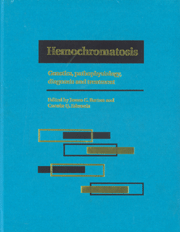Book contents
- Frontmatter
- Contents
- List of contributors
- Foreword
- Part I Introduction to hemochromatosis
- Part II Genetics of hemochromatosis
- 3 Inheritance of hemochromatosis: family studies
- 4 Hemochromatosis: population genetics
- 5 Variation of hemochromatosis prevalence and genotype in national groups
- 6 Human leukocyte antigen (HLA) association and typing in hemochromatosis
- 7 Localization, allelic heterogeneity, and origins of the hemochromatosis gene
- 8 The ancestral haplotype in hemochromatosis
- 9 Evidence for multiple hemochromatosis genes
- Part III Metal absorption and metabolism in hemochromatosis
- Part IV Diagnostic techniques for iron overload
- Part V Complications of iron overload
- Part VI Therapy of hemochromatosis and iron overload
- Part VII Infections and immunity in hemochromatosis
- Part VIII Hemochromatosis heterozygotes
- Part IX Relationship of hemochromatosis to other disorders
- Part X Animal models of hemochromatosis and iron overload
- Part XI Screening for hemochromatosis
- Part XII Hemochromatosis: societal and ethical issues
- Part XIII Final issues
- Index
6 - Human leukocyte antigen (HLA) association and typing in hemochromatosis
from Part II - Genetics of hemochromatosis
Published online by Cambridge University Press: 05 August 2011
- Frontmatter
- Contents
- List of contributors
- Foreword
- Part I Introduction to hemochromatosis
- Part II Genetics of hemochromatosis
- 3 Inheritance of hemochromatosis: family studies
- 4 Hemochromatosis: population genetics
- 5 Variation of hemochromatosis prevalence and genotype in national groups
- 6 Human leukocyte antigen (HLA) association and typing in hemochromatosis
- 7 Localization, allelic heterogeneity, and origins of the hemochromatosis gene
- 8 The ancestral haplotype in hemochromatosis
- 9 Evidence for multiple hemochromatosis genes
- Part III Metal absorption and metabolism in hemochromatosis
- Part IV Diagnostic techniques for iron overload
- Part V Complications of iron overload
- Part VI Therapy of hemochromatosis and iron overload
- Part VII Infections and immunity in hemochromatosis
- Part VIII Hemochromatosis heterozygotes
- Part IX Relationship of hemochromatosis to other disorders
- Part X Animal models of hemochromatosis and iron overload
- Part XI Screening for hemochromatosis
- Part XII Hemochromatosis: societal and ethical issues
- Part XIII Final issues
- Index
Summary
Introduction
After Sheldon's initial suggestion that hemochromatosis might be an ‘inborn error of metabolism’, the question of whether environmental or genetic factors contribute to the familial clustering of the disorder was long debated. By 1970 a genetic causation was generally accepted, but the mode of inheritance was still controversial, despite cogent family data supporting recessive transmission of Saddi and Feingold. Simon discovered the association of hemochromatosis with HLA antigens, confirmed its inheritance as an autosomal recessive disorder, and assigned the hemochromatosis gene to the short arm of chromosome 6 by demonstrating linkage to the Major Histocompatibility Complex (MHC). Simon also initiated a positional cloning strategy based on the search for maximal allelic association and the analysis of hemochromatosis-associated haplotypes, both ancestral and recombinants, under the assumption of a strong founder effect. The latter approach, termed ‘recombinant haplotype mapping’, permitted the prediction that the hemochromatosis gene(s) was distal to HLA-A6. These locations on Ch6p correspond to the critical region in which an HLA class-I like gene (HFE), the best candidate gene for hemochromatosis so far identified, was identified and cloned. This chapter focuses on allelic and haplotypic associations described with serological and molecular markers located at the telomeric end of the MHC with respect to the mapping of the HFE gene. Their practical use in genetic counseling is discussed.
Association studies with serologically defined HLA Markers
The MHC chromosomal region was first suggested as a possible genetic region for the hemochromatosis gene by Simon, who discovered a greater frequency of the HLA-A3 antigen among hemochromatosis patients than controls from the region of Brittany, France.
- Type
- Chapter
- Information
- HemochromatosisGenetics, Pathophysiology, Diagnosis and Treatment, pp. 63 - 74Publisher: Cambridge University PressPrint publication year: 2000
- 8
- Cited by



